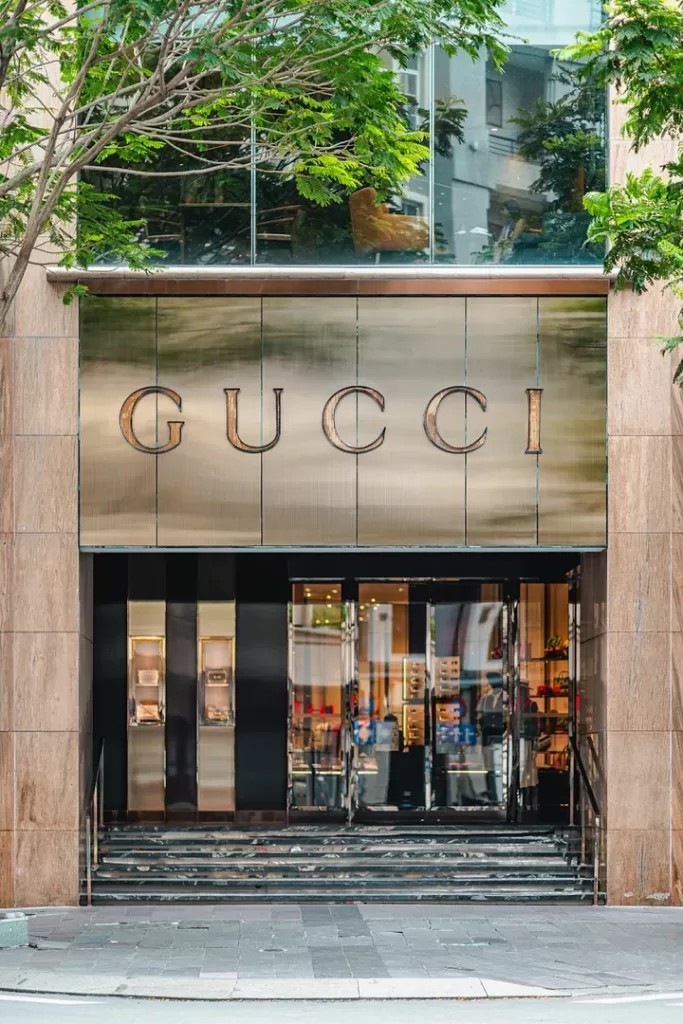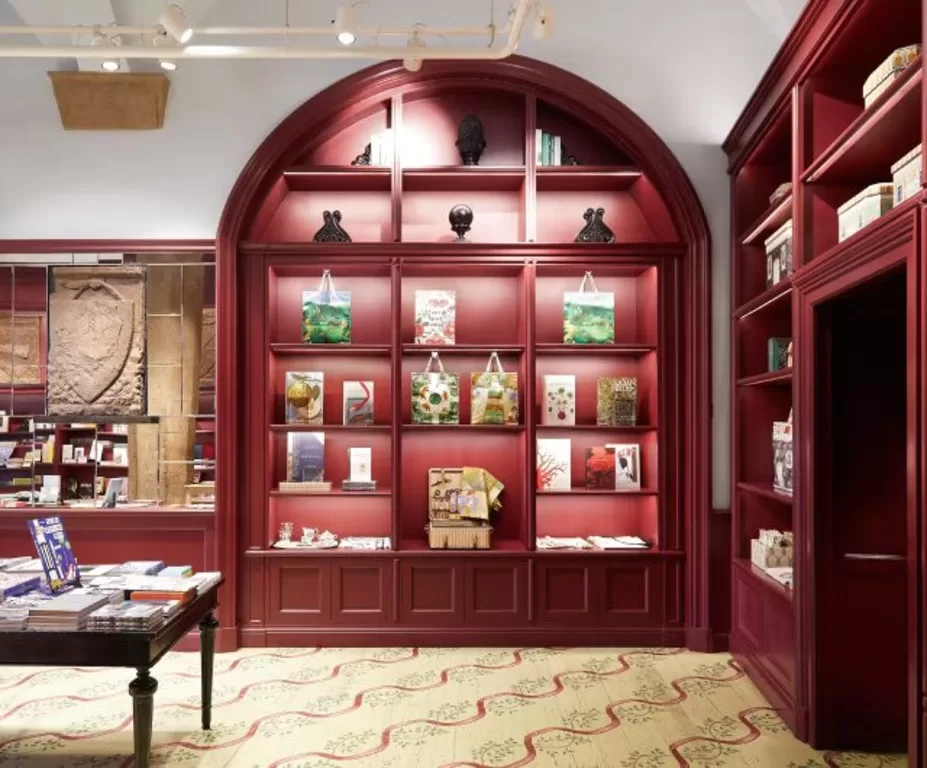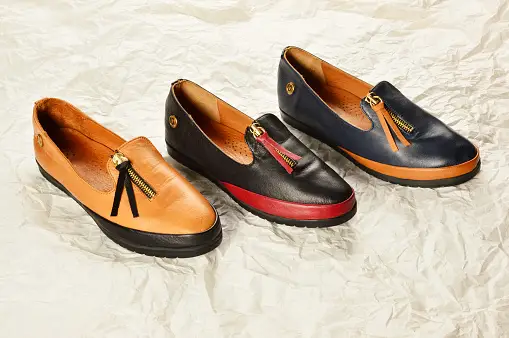Gucci-in the Metropolitan city of Milan
Brief Introduction: The Current State of Gucci
Before delving into the rich history and timeless elegance of Gucci, let’s take a quick look at the current state of the brand and its latest position in the world of art andin the fashion.
Decline in Sales:
Recently, Gucci has faced some financial challenges. In the first half of 2024, the brand reported an 11% drop in sales, leading to €9 billion. The decline was even more pronounced in the second quarter, with sales dropping by 19% to €2 billion. This downward trend began in the first quarter of 2024, when sales decreased by 18%. This decline can be attributed to several factors, including changes in post-pandemic consumer behavior and economic slowdowns in key markets like China. After a booming period during the Covid-19 pandemic in 2021, Gucci now faces inflationary pressures and the emergence of the “silent luxury” trend, which focuses on understated elegance rather than displays of wealth.
New Designer:
Amid these challenges, Gucci has appointed Sabato De Sarno as the new menswear designer. His approach is to infuse a more contemporary atmosphere into classic wardrobe pieces. De Sarno’s debut is highly anticipated and is considered a significant moment for both Gucci and its parent company, Kering. His success will be a crucial factor in determining the future direction and appeal of the brand.
Customer Advisors:
Gucci continues to innovate in customer service, offering advisors available to answer questions via Apple Messages, WhatsApp, or email. This service is available Monday through Saturday from 9:00 AM to 8:00 PM (EST) and Sunday from 10:00 AM to 7:00 PM (EST), excluding holidays. This initiative reflects Gucci’s commitment to maintaining a high level of customer engagement and support.
Market Challenges:
Several factors contribute to Gucci’s current financial difficulties. The luxury market in China, a significant revenue source for Gucci, has faced sluggish conditions due to economic slowdowns and reduced consumer spending in the luxury sector. The French luxury conglomerate Kering, which owns Gucci, has issued warnings about declining revenues, predicting a nearly 20% drop in Gucci’s sales, from $2.8 billion (€2.6 billion) to lower figures.
Introduction
Founded in 1921 by Guccio Gucci in Florence, Tuscany, Gucci quickly became an emblem of Italian luxury and the dolce vita lifestyle under the guidance of Aldo Gucci, Guccio’s son. Despite internal family conflicts leading to the complete ousting of the Gucci family from the company’s capital in 1993, the brand experienced a significant revival. By 1999, Gucci had become a subsidiary of the French conglomerate PPR, now known as Kering.
In 2023, Gucci boasted 538 stores worldwide, employing 20,711 people, and generating €9.9 billion in sales. The leadership included CEO Jean-François Palus, who took the helm in July 2023, and Sabato De Sarno as creative director since January 2023.
Gucci, a name synonymous with luxury, elegance, and innovation, stands as a beacon of Italian craftsmanship and style. From its humble beginnings in Florence to its status as a global fashion powerhouse, Gucci’s journey is a story of visionary leadership, relentless creativity, and a commitment to quality. This blog explores the inspiring history and success of Gucci, examining its impact on the fashion world and its enduring appeal.
The Birth of an Icon: Gucci’s Early Years

Gucci was founded in 1921 by Guccio Gucci in Florence, Italy. Initially, it was a small store specializing in leather goods and accessories. Inspired by the refined aesthetics and superior quality of the luggage he had seen while working at the Savoy Hotel in London, Guccio aimed to bring the same level of sophistication to his creations.
The brand quickly gained a reputation for its impeccable craftsmanship and luxurious materials. By the 1930s, Gucci had expanded its offerings to include handbags, shoes, and clothing, each piece reflecting the brand’s commitment to excellence. Despite the economic challenges of the time, Gucci thrived thanks to its innovative designs and loyal clientele.
Rise to Prominence: Post-War Era

The post-war era marked a significant turning point for Gucci. Under the leadership of Guccio’s sons, Aldo, Vasco, and Rodolfo, the brand expanded internationally. The iconic bamboo-handled bag, introduced in 1947, became an immediate hit and remains a symbol of Gucci’s ingenuity.
In the 1950s and 60s, Gucci’s signature green-red-green stripe and GG logo became recognizable symbols of luxury. Hollywood stars and European nobility embraced the brand, further cementing its status as a symbol of opulence and style. The opening of stores in New York, London, and Tokyo marked the emergence of Gucci as a global fashion icon.
Innovation and Reinvention: The Tom Ford Era

The 1990s were a period of transformation for Gucci. The brand faced financial difficulties and internal conflicts, but a new chapter began with the appointment of Tom Ford as Creative Director in 1994. Ford’s bold vision and daring designs revitalized the brand, blending classic elegance with modern sensuality.
Ford’s collections were a sensation, characterized by sleek silhouettes, luxurious fabrics, and provocative marketing campaigns. His tenure not only revitalized Gucci’s fortunes but also set new standards in the fashion industry. Under his leadership, Gucci became synonymous with glamour and sophistication, attracting a new generation of fashion enthusiasts.
Continuing the Legacy: The Alessandro Michele Era

In 2015, Alessandro Michele took the reins as Creative Director, ushering in a new era of eclecticism and innovation. Michele’s vision embraced a mix of historical references, vibrant colors, and playful designs. His approach resonated with contemporary audiences, propelling Gucci to new heights of popularity and profitability.
Michele’s commitment to sustainability and inclusivity was also a hallmark of his tenure. Initiatives such as the Equilibrium program, which focuses on environmental and social responsibility, reflect Gucci’s evolving ethos. The brand’s embrace of digital innovation and collaborations with artists and designers further solidified its status as a pioneer in the fashion world.
Gucci’s Iconic Products: A Testament to Timeless Elegance

Gucci’s product range is a testament to its versatility and enduring appeal. From cutting-edge clothing to elegant accessories, each item embodies the brand’s dedication to quality and innovation.
Gucci Glasses:


Gucci glasses represent the perfect blend of style and functionality. Each pair of glasses is designed with the utmost attention to detail, using high-quality materials to ensure exceptional comfort and durability. The collections include a wide range of styles, from classic models to bolder ones, suitable for every personality and occasion. Wearing a pair of Gucci glasses means making a style statement, showcasing one’s sophisticated taste. Known for their distinctive designs and superior craftsmanship, these eyewear pieces have become a must-have in the fashion world. Whether it’s the classic aviators or the trendy cat-eye frames, Gucci glasses add a touch of sophistication to any look.
Gucci Loafers:


Gucci loafers are a symbol of timeless elegance. Crafted from fine leathers and finished with artisanal care, these loafers offer unparalleled comfort and refined aesthetics. Whether for a formal or casual look, Gucci loafers add a touch of class to any outfit. The iconic gold bit, present on many models, is a distinctive feature that makes each pair of Gucci loafers instantly recognizable.
Gucci Flora:

Gucci Flora is a collection of perfumes that celebrates the beauty and delicacy of flowers. Each fragrance is an ode to nature, with floral notes that evoke images of enchanted gardens and spring days. The bottles, elegantly decorated with floral motifs, reflect the grace and elegance of the perfumes inside. Gucci Flora is a perfect choice for women who want a fragrance that is both fresh and sophisticated.
Gucci Guilty:

Gucci Guilty is a line of bold and provocative fragrances that challenge conventions. Launched in 2010, it quickly gained a cult following for its daring blend of notes and seductive packaging. Variants like Gucci Guilty Black, Gucci Guilty Elixir, and Gucci Guilty Cologne have expanded the line, each offering a unique olfactory experience.
Gucci Guilty: The Scent of Rebellion

Gucci Guilty is a line of bold and provocative fragrances, designed for those who aren’t afraid to express their individuality. With intense and seductive notes, each fragrance in the Gucci Guilty collection is a declaration of freedom and independence. From the classic version to Black, each variation of Gucci Guilty offers a unique olfactory experience, perfect for those who want to make a statement.
Gucci Guilty Black: Dark Seduction

Gucci Guilty Black is the most intense and sensual version of the collection. With a mix of oriental and woody notes, this perfume captures the essence of night and mystery. Ideal for special occasions, Gucci Guilty Black is designed for those who love to stand out with a fragrance that doesn’t go unnoticed. The black bottle, elegant and mysterious, perfectly reflects the character of the perfume inside.
Gucci Guilty Elixir: A Luxurious Experience
Gucci Guilty Elixir is a fragrance that embodies luxury and opulence. With rich and enveloping notes, this perfume offers a sophisticated and memorable olfactory experience. Every spray of Gucci Guilty Elixir is a sensory journey that transports the wearer to a world of elegance and refinement. Perfect for special evenings, this perfume is a celebration of luxury in all its forms.
Gucci Guilty Cologne: Freshness and Refinement
Gucci Guilty Cologne is a fresh and modern reinterpretation of the classic Gucci Guilty fragrance. With citrus and aromatic notes, this cologne
The Impact of Gucci: Beyond Fashion

Gucci’s influence extends beyond the realm of fashion. The brand has been a pioneer in cultural and social initiatives, leveraging its platform to advocate for positive change.
Sustainability and Social Responsibility

Gucci’s Equilibrium program underscores its commitment to sustainability and social responsibility. Initiatives such as carbon neutrality, responsible sourcing, and community engagement reflect the brand’s dedication to creating a positive impact. Gucci’s efforts in promoting gender equality, diversity, and inclusion have also set new benchmarks in the fashion industry.
Digital Innovation and Cultural Engagement

Gucci has embraced digital innovation to connect with a global audience. From virtual reality experiences to immersive fashion shows, the brand has leveraged technology to create engaging and interactive experiences. Collaborations with artists, musicians, and filmmakers have further enriched Gucci’s cultural relevance, positioning it as a leader in contemporary fashion.
Gucci’s Enduring Legacy

Gucci’s journey from a small leather goods shop in Florence to a global fashion powerhouse is a testament to its enduring appeal and visionary leadership. The brand’s commitment to quality, innovation, and social responsibility has solidified its status as the pride of Italy and a symbol of luxury worldwide.
As Gucci continues to evolve and inspire, it remains a beacon of style and sophistication. Its iconic products, from Gucci glasses to Gucci loafers, and its groundbreaking fragrances like Gucci Flora and Gucci Guilty, embody the brand’s timeless elegance and innovative spirit. For fashion enthusiasts and aspiring designers alike, Gucci’s story is a source of inspiration and a reminder of the transformative power of creativity and vision.
#GucciLegacy #LuxuryFashion #ItalianElegance #GucciInnovation #FashionInspiration

